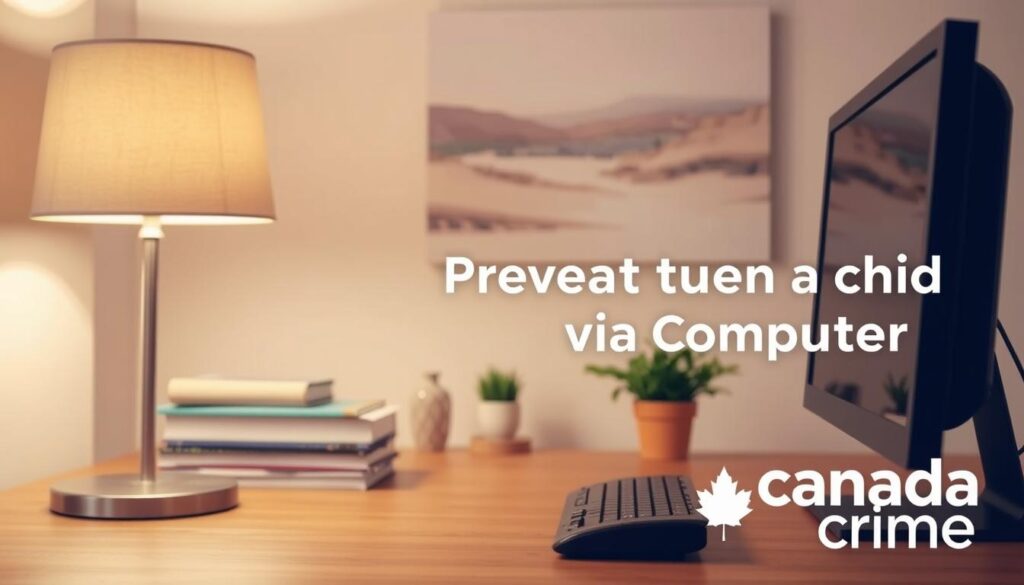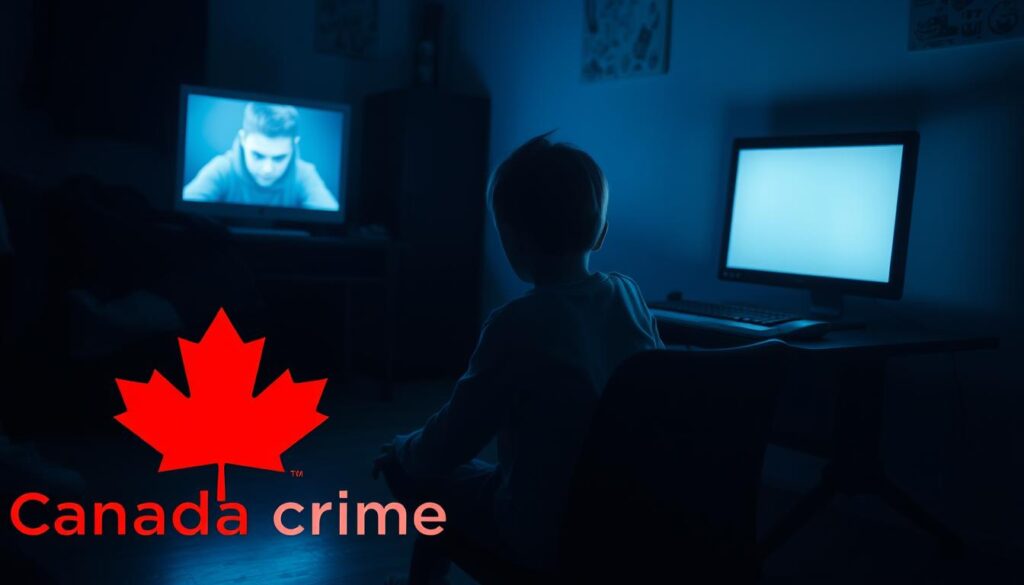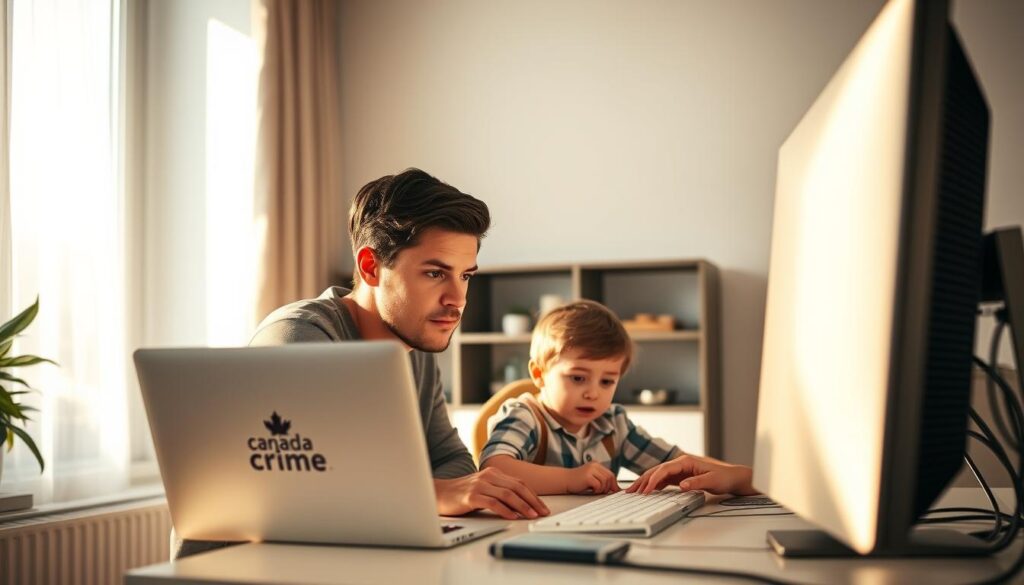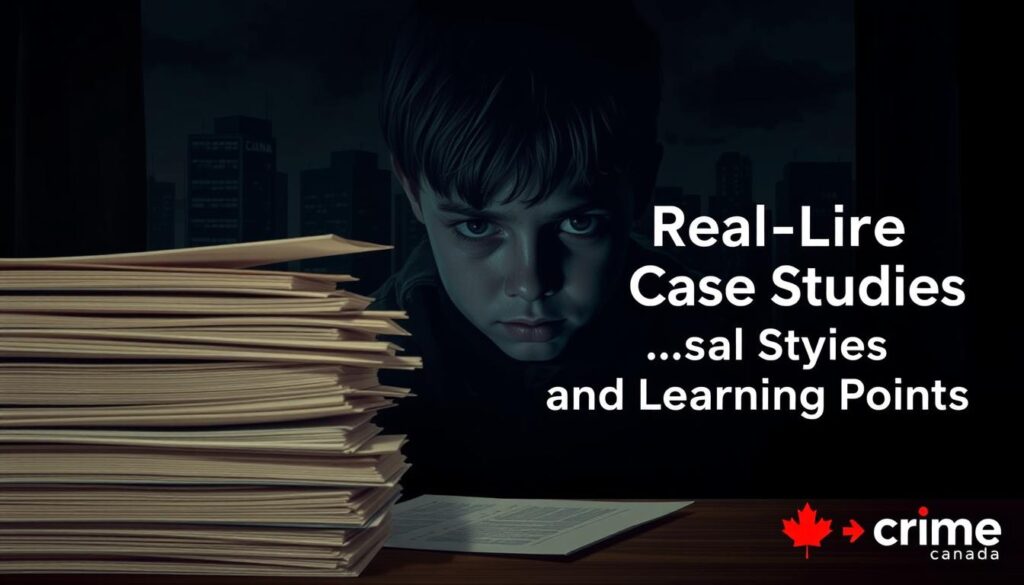Did you know 55% of kids in Canada, ages 8-12, have shared info with strangers online? With more kids online, keeping them safe is crucial.
In our digital world, we must keep kids safe from online dangers. Parents need the right knowledge and tools to secure internet safety for youth. This article shares important tips to protect your children from online threats.
Understanding the Importance of Online Safety
Today, kids use digital technology daily, making internet safety critical. Parents must protect their children from online dangers. This includes cyber threats that can harm them for a long time. Keeping the online world safe is about more than just security. It’s also about creating a community that’s careful and smart.
Why Online Safety Matters
Children are using the internet more for learning, making friends, and fun. But being online can lead to risks like cyberbullying, seeing bad content, and dangerous people. Knowing how to keep kids safe online can lower these dangers. This helps keep the internet a safe place for them. Teaching kids about online safety is a key step in keeping them safe online.
Statistics on Online Child Exploitation in Canada
Online child exploitation is a big worry in Canada, highlighted by shocking numbers. The Canadian Centre for Child Protection reports a big jump in cases. This shows we need to act fast to stop it.
| Year | Reported Cases | Percentage Increase |
|---|---|---|
| 2018 | 6,500 | 15% |
| 2019 | 7,800 | 20% |
| 2020 | 10,000 | 28% |
The increase in online child exploitation is alarming. By learning and using strong internet safety steps, you can help keep children safe online. This is vital for making sure they stay safe in this digital era.
Know the Technology Your Child Uses
Kids today dive into the digital world early. They use everything from smartphones to gaming consoles. Each device and app comes with both cool features and risks. Knowing about these helps you guide and keep your child safe.
Setting up parental control setups is crucial. It helps you watch over and limit what content your child can see. We’ll go over what to watch for and how to set things up safely.
Overview of Common Devices and Apps
Despite changes in tech, some devices always seem to be in kids’ hands:
- Smartphones: Widely used for communication, games, and social media.
- Tablets: Popular for their portability and ease of use, often used for educational apps and entertainment.
- Gaming Consoles: Used for interactive gaming and connecting with friends online.
Children use a range of apps like YouTube Kids, Roblox, TikTok, and Khan Academy. These apps are exciting but they have risks like running into bad content or online strangers.

Setting Up Parental Controls
To keep your child safe, use parental controls on their devices. Below are steps to do that:
- Smartphones: iOS and Android phones have parental controls. These can limit app use, block bad content, and control screen time.
- Tablets: Tablets offer tools like Google Family Link and Apple Screen Time to set limits and filter what’s seen.
- Gaming Consoles: Consoles like Xbox and PlayStation have family settings. They help control playtime, who your child talks to, and game access.
By knowing and using these parental control features, you make sure your child’s online adventures are both fun and safe.
How Luring and Grooming of Children Occurs Online
Understanding how online predators groom and lure kids is key to keeping them safe. They follow specific steps to win a child’s trust and control them. Knowing these tactics helps spot dangers early.
Common Platforms Used by Predators
Predators often target kids on social media, online games, and chat forums. These platforms make it easy for them to start and build a connection. Knowing where predators lurk aids in spotting threats quickly.

| Platform | Usage by Predators |
|---|---|
| Social Media (e.g., Facebook, Instagram) | Connecting via friend requests and direct messaging to appear trustworthy. |
| Online Games (e.g., Fortnite, Minecraft) | Engaging with children through game chats to slowly build rapport. |
| Chat Forums (e.g., Reddit, Discord) | Participating in discussions, sharing interests, and gaining trust to lure children. |
Recognizing Grooming Tactics
It’s vital to recognize grooming tactics to spot online luring. Predators use careful methods to sway their victims. Key signs include:
- Overly Friendly Behavior: Excessive flattery or kindness designed to lower the child’s defenses.
- Requests for Personal Information: Asking for details like addresses, phone numbers, or school names under various excuses.
- Sharing Inappropriate Material: Sending explicit content to make the child used to sexual content and see how they react.
By being aware of these tactics, parents and kids can be more vigilant. This helps avoid online threats and maintain a safer online environment.
Tips to Prevent Luring a Child via Computer
Parents and caregivers are key in protecting children from online dangers. To keep them safe, you need to take steps ahead of time. This includes setting up strict privacy controls on all their devices and online accounts. Make sure to check and adjust these controls often to fight off new online threats.

It’s vital to teach kids about the risks of sharing personal info online. They should know to keep things like their address and phone number private. Make it clear that people online might not be who they say they are, making it easy for harmful individuals to seem trustworthy.
Talking regularly about online behavior is crucial. Tell kids to inform an adult right away if they feel uncomfortable online. This could be on social media, in online games, or on chat apps. Make sure they know their safety comes first and they won’t be in trouble for speaking up about strange interactions.
To further prevent online predators, keep an eye on your child’s internet use. But, it’s important to maintain a balance and respect their need for private space. Use tools that help you monitor their activity without reading their messages. Having open talks about these steps helps your child see it’s for their safety, not about mistrust.
Using online resources for tips on protecting against online predators is a good move. These guides offer strong strategies and hands-on tips for keeping your child safe from online tricks.
Below are some quick tips summarized in a table for easy recall:
| Tip | Description |
|---|---|
| Privacy Settings | Ensure all devices and accounts have up-to-date privacy settings. |
| Educate on Personal Information | Teach children the importance of not sharing private details. |
| Report Uncomfortable Interactions | Encourage children to inform adults about any suspicious online activities. |
| Regular Monitoring | Monitor online activities while respecting privacy for a balanced approach. |
| Utilize Resources | Refer to online guides and materials for further safeguarding strategies. |
Setting Boundaries and Rules for Online Usage
Making clear rules for internet use is crucial for kids’ safety online. Setting up these rules helps children know what they should and shouldn’t do on the internet.
Creating a Safe Browsing Environment
To keep kids safe online, start by learning about the tech they use. This means putting in parental controls, watching the apps they get, and setting limits on what they can see. Keeping your security software up-to-date helps keep bad content away.
Making a safe online space makes sure browsing is good for kids. By taking these steps early, you make your home digitally secure.

Encouraging Open Communication
Talking openly with your kids about internet safety is very important. Ask them to share their online experiences and if something makes them uneasy.
Make sure they know they can talk to you without being afraid of getting in trouble. This builds trust, encourages honesty, and keeps them safer online. Check out this report on online exploitation rates for more info.
When you set clear online rules and focus on safe internet habits, you protect your kids from online dangers. This makes their time on the internet both fun and safe.
Teaching Kids About Online Stranger Danger
Educating children about online stranger danger is vital in our tech-savvy world. It’s important to teach them about the risks of talking to unknown people online. Using interactive and informative activities can help stress the need for caution and privacy online.

Role-Playing Scenarios
Using role-play to teach internet safety is very effective. It lets children practice handling situations with online strangers. You can help them learn to spot danger signs and know how to respond. Practicing various scenarios prepares them to deal with actual situations.
Educating on Privacy and Personal Information
Keeping children’s privacy safe online is incredibly important. Teach them to never share personal details like their name, where they live, or their school. Talk about the dangers of sharing too much online. Emphasizing privacy teaches them to be cautious in the digital world.
Monitoring and Supervising Online Activity
It’s vital to keep an eye on kids while they’re online to protect them. You can make the digital world safer by using good tools to watch over internet use. It’s also key to spot signs of child exploitation early.

Effective Monitoring Tools
Parents have many tools at their disposal for keeping tabs on their kids’ online activities. These include software and devices:
| Tool | Description |
|---|---|
| Net Nanny | Provides content filtering, time management, and social media monitoring. |
| Qustodio | Offers web filtering, screen time control, and detailed activity reports. |
| bark | Analyzes text messages, emails, and social media for potential risks. |
Warning Signs of Online Exploitation
Knowing the warning signs of child exploitation is crucial for stopping it early. Watch out for changes in your child’s behavior, secrecy about their online life, or surprise gifts from someone they don’t know. These signs might mean someone is exploiting them online.
Legal Protections and Resources in Canada
It’s very important to understand legal protection to fight online child dangers. Canada has strong rules to keep children safe online. Knowing about Canada’s internet safety laws helps you protect your children better on the web.
Canadian Law on Online Exploitation
Canada’s laws protect well against online harm. The Criminal Code of Canada has parts that fight against using the internet for bad purposes. This includes luring children and sharing harmful images. As digital dangers grow, these laws also change to keep offering solid online safety.
Reporting Online Exploitation
It’s vital to report child harm to protect kids. The Canadian Centre for Child Protection runs Cybertip.ca for reporting doubts. Working with local police makes these reports even stronger, leading to actions against those who break the law.
Get to know these tools for reporting:
| Resource | Description |
|---|---|
| Cybertip.ca | National tipline for reporting child exploitation |
| Kids Help Phone | 24/7 support for children in crisis |
| Local Law Enforcement | Immediate assistance and investigation of reported crimes |
Using these legal tools for online safety helps catch wrongdoers. This creates a safer online space for kids in Canada.
Discussing the Consequences of Sexting and Sharing Explicit Content
Sexting and sharing explicit content can seriously affect children and teenagers. It is crucial to consider both the psychological effects on children and the legal issues with sharing explicit content.
The Psychological Impact
The psychological effects on children involved in sexting are deep. They may feel emotional distress, anxiety, and depression. Besides, they might suffer from social stigma that hurts their self-esteem and friendships.
The harm from sharing just one explicit photo can hurt a child for a long time. It can lead to lasting emotional issues.

Legal Risks and Ramifications
Legal issues with sharing explicit content are serious for children and teenagers. In Canada, minors sharing sexual content can break the law, possibly leading to criminal charges. Sharing these images, even without harmful intent, can be seen as distributing child pornography. This is a severe crime that can have enduring legal effects.
Understanding both the mental health and legal risks of sexting is key to protecting children. Teaching them about these dangers is crucial. It helps prevent such issues and guides them in safe online behavior.
Resources for Parents and Caregivers
Ensuring your child’s safety online requires vigilance and the right resources today. Here, we share key information about platforms and services for support and guidance.
Online Safety Websites
Websites focused on resources for internet safety are available for parents and caregivers. They offer useful advice, rules, and news on the latest safety steps online.
- Common Sense Media: Offers comprehensive reviews and recommendations for safe and kid-friendly apps, games, and websites.
- NetSmartz: An educational program offering interactive resources to teach children how to be safe online.
- Canadian Centre for Child Protection: Provides information and tools to help protect children from victimization online.
Support Services and Hotlines
For extra parental support for online protection, there are services and hotlines. They help with concerns and reporting suspect activities. Using these resources is key for your child’s safe online experience.
| Service | Description | Contact |
|---|---|---|
| Cybertip.ca | Canada’s national tipline for reporting the online sexual exploitation of children. | 1-866-658-9022 |
| Kids Help Phone | Provides confidential counseling and referrals for youth dealing with online issues. | 1-800-668-6868 |

These safety hotlines help create a safer online world for kids. They’re crucial, whether for learning through websites or contacting support services. Taking action in online safety matters a lot.
Real-Life Case Studies and Learning Points
Looking into real-life cases, like the sad story from British Columbia, teaches us a lot. We learn how to stop child exploitation by turning advice into action.
Case Study: McCarty Case in B.C.
The McCarty story shows a time when young people were tricked into harmful situations. McCarty used social media and fake names to harm minors. This teaches us how far some people will go to take advantage of others.

Lessons Learned and Preventative Measures
The McCarty case teaches us many ways to keep kids safe:
- Early Education: Teach kids about the dangers online and what predators might do.
- Active Monitoring: Keep an eye on what your kids do online and talk with them.
- Enforce Strict Privacy Settings: Make sure all devices and apps are secure.
- Prompt Reporting: Tell kids to speak up if something feels wrong.
Here’s a quick look at the main tips to keep children safe:
| Key Prevention Tips | Implementation Strategies |
|---|---|
| Early Education | Have regular talks about staying safe online; practice through role-play. |
| Active Monitoring | Use apps to control access; check often on your child’s online friends. |
| Strict Privacy Settings | Always update safety features on gadgets and online profiles. |
| Prompt Reporting | Help kids feel okay about reporting bad experiences; show them how. |
By using these tips from real stories, we can make the online world safer for kids. They’ll feel more secure exploring the internet.
Conclusion
As we wrap up this guide about keeping kids safe online, let’s not forget what’s most important. It’s vital to teach both yourself and your kids about online dangers. Knowing what devices and apps they use is a good start. Also, be aware of places like Instagram, Facebook, Snapchat, and WhatsApp where dangers can lurk.
To make the internet safer for your child, setting up parental controls is a smart move. Always talk openly with your child and ensure their internet space is secure. Keeping a close watch on their online activities is crucial. And it’s also important to know your rights and the help you can get in Canada. For deeper insights, check out the advice from Public Safety Canada.
In today’s world, staying in touch with your kids about internet risks is key. Being proactive and informed helps protect them from being tricked or harmed online. Let these tips on stopping online tricks guide your steps towards a safer internet for everyone at home.

